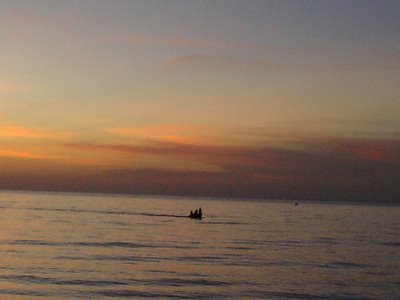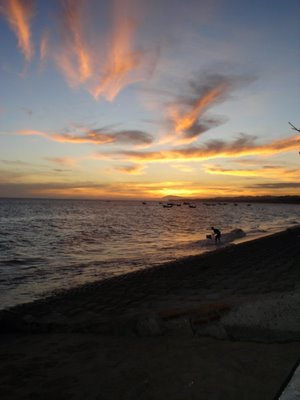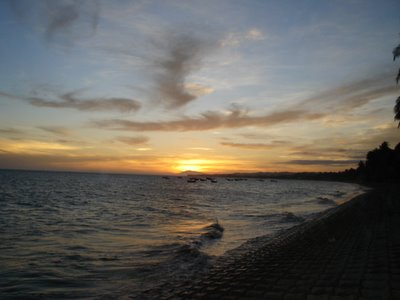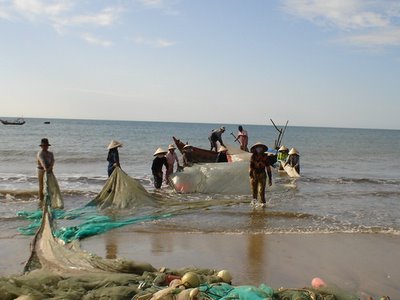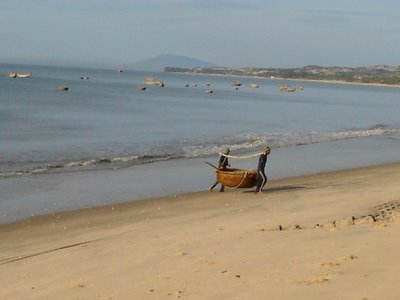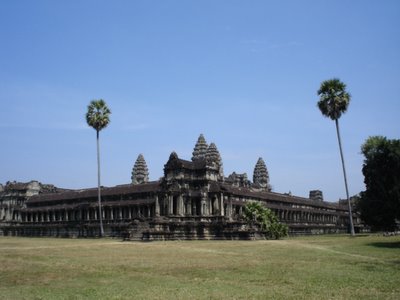
There’s this theory that the Pyramids in Egypt, the Mayan Temples in Mexico, and the Temples of Angkor are all offshoots of Atlantis. I am beginning to give some credence to this hypothesis. I’ve been to them all and the similarities are stronger than the differences.
All are built in alignment to various phases of the sun, the moon, and the cosmos in general. They are all massive structures, precisely and intricately constructed. Some question how the contractors of a few thousand years ago had the knowledge to erect such edifices. If one culture alone had achieved such mastery, maybe there would be no other-worldly theories. But three such peoples, in such far flung locations, gives rise to the thought that there is a connection.
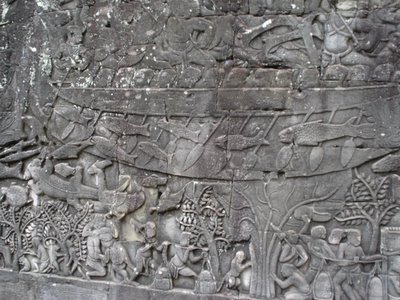
What really struck me at Angkor, was the similarity between the bas-reliefs in the temples and those in the Egyptian tombs. Both are divided into layers; the underworld or ocean, earth, and heaven. In both, a story is laid out along a long wall. The scenes depicted are intensely dense with figures of people, or plants, or animals. I especially noted the bottom layer of crocodiles and fish and other sea creatures, and how it looked so much like the Egyptian walls I’d seen.
But back to day tree of the Temple Tour, which I decided, due to my less than stellar health situation, would just be to Angkor Wat. I knew I had been there, but for the life of me, couldn’t remember what I had seen. I decided to go at noon.
When I got there it was fairly deserted and very quiet. As I walked down the causeway, it all started to come back to me. Once inside, I did remember my first time through, and recalled what my guide had told me. This visit, I really took my time. I walked around the temple, first through the corridors, then through the inner areas, and finally out onto the grounds, where I sat in a far corner under some trees. From my vantage point, I had a wonderful view of the nearly empty temple with no people or voices to intrude upon my solitude.

Walking back, this time on the grounds as far as I could get from the causeway, I got a much better sense of just how large Angkor Wat is, and how far it is from the front gate to the middle of the temple. It would really be a pain to run errands in and out of there all day. I wondered if that is what some people did back in the day.
I thought about going to a few other places I had not yet seen, but just wasn’t up to it. I had enjoyed every minute of every site I had been to, and trudging on to another temple when I felt like crap, didn’t seem to make any sense. I in no way felt cheated out of Seeing It All. As it was, my brain could barely sort out the previous few days.
The next day, my final in Siem Reap, I had the morning for last minute shopping. Much as I didn’t want to wade through the sewer-streets, I did want to get a few scarves. By noon I was packed and checked out, then took a rest in the upstairs terrace room at the Banana. It is a beautiful, tiled, rectangular area, with a roof and giant fans. I lay down on cushions and let my mind drift.
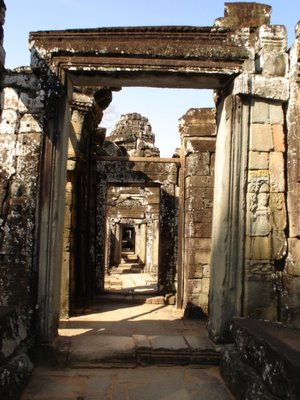
My tuk-tuk driver took me to the airport at 3:30, for my 5:20 flight. I was back in my apartment by 7pm, which was the strangest feeling. I had gone from an exotic, foreign country, to my house in a 40 minute flight. Usually, one needs to fly for twenty hours to do that. Then I remembered that I still live in an exotic, foreign country.
Sometime after returning, I realized that I had not thought of work for even one minute the entire time in Siem Reap. In fact, I really hadn’t thought about anything but the here and now. I have never been able to do that before and certainly wasn’t even aware that I had shut off the rest of my life for an entire five days. And yes, I took the wrong clothes; I didn’t need the extra sheet; I had a miserable cold; but none of that mattered. It had to be one of the best vacations of my life!
Think about that Atlantis thing.
Kate


The main language spoken in Cambodia is Khmer, not ‘Cambodian”, as I have miscalled it. I have seen the written form for years and have always been fascinated by its beautiful, dancing letters. The same is true for Indian script. You would have thought that I would have realized there was a connection between the two, but I didn’t until I was in Cambodia. Written Khmer has a Sanskrit origin, and that is all the presumed linguistic knowledge I will attempt for today.
Possibly, had I paid more attention to the fact that the Angkor temples were originally Hindu, I might have picked up on the language connection. It would appear that I have a lot of reading to do. But as I said before, I have to be in a place before I can internalize the basics like what language was spoken and what religion was practiced.
However, none of my cultural stupidity interfered with enjoying Day 2 of Temple Touring. Not even the sore throat that had turned into a nasty cold overnight could hinder the pleasure of being in Cambodia, although it did knock the exploring down a notch or two.
My tuk-tuk driver was waiting for me at 7am. I hadn’t spoken to him much the day before, but had correctly assumed that he knew where to go and at what time. I pulled out my Temple map and we plotted the first part of the day. I knew I wanted to go back to Bayon in the early morning hours when I hoped there would be very few others around, and I was right.
I walked into the temple grounds all alone, with just the sounds of the birds and a few, far-off voices. I was in heaven as I meandered through the walkways and corridors, often with no one insight and no voices to be heard. Now this was the type of ruins exploring I loved. It didn’t matter that I didn’t know what every carving symbolized, or that the temple was laid out in a very specific form. I didn’t need to know the details of what year this section was built and under what king changes had occurred. You see, you can just feel all of that. And if I were to stop and read something in a guide book, I would loose the connection. It was why I had only hired a guide for one day. In the isolation of ancient places, one needs only to rely on the voices and energies of the surroundings, which will speak to you if you listen carefully.

Eventually, I did move on to the next temple, one I had not visited the day before. It seemed that with most of the places I visited, you needed to first walk up a narrow, tree lined trail, before reaching the temple. On these trails I would often encounter small groups playing traditional music. Beautiful melodies drifted down the trail, accompanying your step as you approached the entrance. When you finally reach them, you find out that they are made up of landmine victims.
The first two groups I had heard at two other temples, were made up of all men, aged early 20’s to mid 30’s. I would stop and listen for a few minutes, then make a donation and thank the musicians. The third group I could only hear as I roamed around the temple. Their sweet sounds flowing through the columns and vaults. It wasn’t until I exited through the back entrance that I saw them.
This group was made up of boys and girls, men and women. When they finished one of their songs, I went up to put money in the donation box and ended up sitting down to talk to the director, himself a landmine victim. He founded the Angkor Association for the Disabled, which trains musicians and also has many projects going on in Siem Reap. Bookseller carts, in the center of town, are one the ways he has helped to enable people who, in the past, would not have been employable. The youngest of this musical group was a beautiful girl, maybe twelve years old. She played a stringed instrument that sits on the ground or on a table. I was taken by her musical ability. The director told me that she had only been playing for 15 days!
Their music carried me back through the temple and back on to the path out. Just as I stepped onto the trail, I stopped to look at the carved art work of an older gentleman. He sat carving while a young girl, possibly his granddaughter, stood next to a small table with items for sale. I was immediately drawn to the elegantly carved wooden egrets; three of them standing together on a piece of wood. They had articulated necks with their heads attached to strings which, in turn connected, puppet-style, to a wooden bar. The whole apparatus hung from a hook, and the egrets’ heads bobbed up and down. I had to have this. The artist told me it had taken him two days to make.

Back at the tuk-tuk, I showed my birds to the driver and then suggested we walk across the street and get something to drink. We sat at a table set up under an awning. My driver knew all of the people and helped translate when I bought a few t-shirts. The one I really wanted was only in a size L. And in Asia, I am a size XXXL. The women wouldn’t believe me and said I was very small for a foreigner. She told me to try it on, and even though I knew it wouldn’t fit, I really wanted it, so agreed. Where does one try on a shirt in a side-of-the-road shop? No problem; she held up a length of material while I tried to squeeze myself into the top. She assured me that if I washed it and stretched it, it would fit. I bought a couple of XXL men’s t-shirts instead.
While resting, I told my driver that I was really interested in other local crafts, such as my egrets, and asked if he knew where to find such items. He said that there was a basket making store close to the Banana, and would take me there when we got back. I think I did one more site before I called it a day.
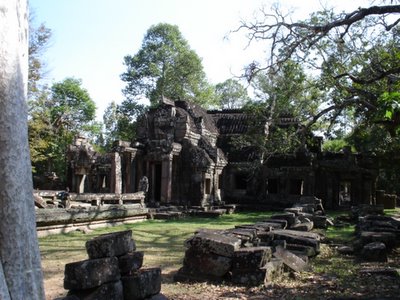
We drove by the Banana, down a dirt ally, then onto to a slightly larger dirt street and stopped in front of a house that had two large baskets out front. My driver pointed to the house across the street and said it was his mother’s house that he had lived in until two years ago when he had married and gone to live with his wife’s family.
I should point out that all the houses I had passed were small places, built on stilts. The basket workshop was much larger, and the area under the stilts had been turned into a production studio. Women sat on the floor weaving large, laundry style baskets. It was great to see, but I was looking for the finer woven, small baskets. I was then directed to go inside and into another room. There, displayed on shelves, was an array intricately woven baskets in all sorts of interesting shapes and sizes. I also noticed a sign saying it was a Fair trade organization. I started asking prices. They started at $3, and I started picking ones to buy. Then I noticed these purses that were made from some sort of dried, dyed, Delta grass. As with the baskets, their shapes were amazingly unique, and the quality superior. I would have bought more but I started to worry about getting them on the plane. I stopped myself from purchasing a large, laundry basket, and filling it to the brim. One has only so much room in which to display artwork.

It had been another great day, which was not yet over. I had dinner plans with a few of my new found friends. I spent my one night on the town, first eating at a place that looked like someone’s idea of what a funky, Ft Lauderdale seafood restaurant would look like. Probably styled after something they’d seen in a movie or on MTV. The restaurant was a series of levels and platforms with low tables on each one where you sat on cushions. Lighting was sort of bluish and dim. In the middle, on a raised stage, they had a live, Philippino band. The gals could sing any song you requested, all the while dancing around in gigantic platform shoes. The wait staff wore t-shirts and jeans and had gangster-tied bandanas on their heads.
I sat next to my friends and we were joined by four of their friends from Siem Reap. It was really fun, the food was good, but I had to keep moving around to get comfortable. Fortunately, I could actually lie down if the back or knees got too stressed from sitting in a not-normal-for-me position. After dinner, we walked around the corner to a cozy little, quiet pub. At 11:00, I wussed out and went back to the Banana. Tomorrow would be the last day my temple pass was valid and I wanted to be ready for it.
I’m not sure if there is anything more to tell, but you will soon know.
Kate

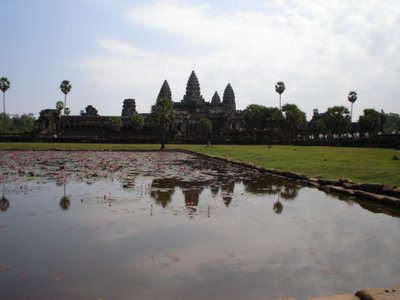
Before doing a bit of research on the temples of Angkor, I had thought that all I would need to do is get out there and wander around. Not so. The Angkor Archeological Park is 400 square kilometers, and there are at least forty different temples listed on my tour map. You have a few choices: Hire a car and driver, go on the back of a motorbike, rent a bicycle, or hire a tuk-tuk. I chose the last option.
A tuk-tuk is a covered cart/carriage, attached by a trailer hitch to a motorcycle. The bench seat accommodates two and a half people comfortably, and there is a place to sit directly opposite the bench, with your back to the driver. I would say three people should be the maximum, but I did see a tuk-tuk with at least five, saffron-robed monks, cruising along the road. On my first day out I also decided to get a guide. Generally, I like to explore on my own, but I simply didn’t know enough and Angkor is too big to just ramble through with no real idea of where you are headed.

Another reason for having a guide is to know when to go to which temple to avoid the onslaught of tour buses. Even though I was there at the height of tourist season, I was able to visit most of the sites when there were very few other tourists.
Not having a clue as to where to go/what to see, I left it up to the pros. At 7:15, we jumped in the tuk-tuk, and took off on a rather bumpity, cold, fifteen minute jaunt through the streets of Siem Reap and out to the park. Stopping at the massive entrance facility, I handed over my cash and a photo to my guide who took care of purchasing my three day pass. (One side note about the cost: A one day pass is $20, a three day, $40. That is not cheap, but it supports the preservation of the park. Or so I thought. It turns out that almost all the money goes to a private company that “administers” the site.) My guide returned in a few minutes with a laminated, photo ID, pass.

Our first stop was to be Angkor Thom, a walled, moated city with lots of temples inside. My guide said that it would be better to drive past Angkor Wat, and go straight to Angkor Thom, so as to avoid the morning crowds at the former. As I think I have already said, I had only known the very basics about Angkor before going there. (and that still is fairly true). I am just not good at reading about a place and retaining any of the information prior to actually seeing it. The fact that I did know that Angkor Wat was surrounded by a moat did not prepare me for the majestic sight of it in the early morning, sitting smack dab in the middle of a lake.
You can call it a moat, but at 570 feet wide, and four miles long, I’m calling it a lake.

But back to Angkor Thom. Five causeways lead into the city that is laid out in a square, each side being about three kilometers long. I think we entered by the south gate, and went straight to Bayon, which turned out to be my favorite of all the temples I was to explore. It is the one with 216 faces carved into 54 towers.
As I walked up onto the various levels, I got closer and closer to the faces, until some of them were right in front of me. Each giant face was much taller then me, maybe around eight feet high. Every which way I turned, there was another smiling face. Totally mesmerizing.
From there, we went to several other temples within Angkor Thom. My guide was very knowledgeable and helpful, but if you asked which sites we visited, and in which order, I couldn’t tell you with certainty. Day one was fantastic, but it did become a blur in my mind. Not only was it sensory overload, but a real physical workout, that one doesn’t notice until the early afternoon.

Inside, the temples are constructed with long corridors that are broken about every two or three meters, by a foot high ledge, breaking the halls into separate, yet connected, vaults. They are too high and too wide to step over. So as you walk along it is a repetitious up, down, step, step, step, up, down, and so forth in a seemingly never ending trek around the temple.
As far as going up the 85 degree angle of five inch wide steps to reach some of the top towers, I opted out. And it has nothing to do with the physicality of the task. I simply do not like heights, and once up there would never again make it back down.
Finishing the rounds of Angkor Thom, we jumped in the tuk-tuk and headed back to Angkor Wat. It was a good time to visit, being around noon and all the tour buses had taken their flocks back to the hotels for lunch. By then, the chill had been replaced by hot sun, for which I was grateful. It was kind of tough walking through areas without any cover from the sun, but once inside a temple, it was pleasantly cool.

We did a quick tour of Angkor Wat, then decided to break for lunch. Next to, or across from all of the sites, there are dozens of souvenir shops and food stalls and open-air restaurants. There are also hundreds of kids hawking their wares. They have learned all the usual English sentences: “Are you thirsty, do you want water?” Or, in the morning when it is chilly: “It’s cold today. Do you want coffee?” “Buy some postcards; buy some bracelets; how about a t-shirt?” And if you engage them with anything more than a pleasant “No, thank you”, you will be immediately swamped by ten other kids with items for sale. My favorite was “Where are you from?” to which I answered, California, to which the little girl said, “I’m from Sacramento.” Talking to the folks back at the Banana, it turns out that most of them have memorized the capitals of all the fifty states and all major countries. Jeeze, I don’t even know all the capitols!

My driver and guide took me to one of the very large restaurants. It stood under a grove of trees and was built of a concrete floor with a thatched roof and a bamboo wall on one side, the other wall was open, making it cool and breezy. There must have been a hundred tables in neat rows, but only a few patrons, being past the lunch hour. Even though I told the guys that I would buy their lunch, they chose to eat with some of the other drivers at the back of the restaurant. I got a sort of curried vegetable dish that was quite good.
After we ate, we drove out to Ta Prohm, the temple I have always envisioned when Angkor is mentioned. It’s the one that the jungle got to. The trees are on a quest to take back their territory, and grow in and out, over and around, the stone walls and rooms and everything in its way. I was surprised at the size. It was smaller than I had thought but nonetheless fascinating and beautiful.

There were still more hours of daylight, but my brain was on temple overload and just wouldn’t take in any more, so we headed home in our lovely tuk-tuk, the warm air blowing over me, the dust blowing up my nose and into my mouth. As we drove on the small road past fields and trees and open spaces, I tired to recall the day’s events, but everything was jumbled up in my head. I knew I hadn’t spent enough time at Angkor Wat. I decided that I would go out the next day with just my driver. I was really glad for the guide, but also knew I preferred to walk alone amongst the ancient spirits.
Back at the Banana, I showered off the sweat and dust, then went out to the courtyard. I sat at a table, ordered a drink, and talked to some of the staff about my day. Soon other explorers returned, or new guests arrived. We exchanged stories, I asked for more Temple Touring Tips, as well as info on where to shop. We talked about where we were from, what we did, where we’d traveled. One conversation with one person would end when they left for the shower or a rest, and another would begin. I couldn’t believe it was already after 7pm, and people were making plans to go into town for dinner. Not being a big dinner person, and being tired, and noticing that my throat was starting to hurt, I declined their offers. This really was the best place I had ever stayed. The temples were spectacular, but to come home to the camaraderie of fun, interesting people, made it so much more worth while.
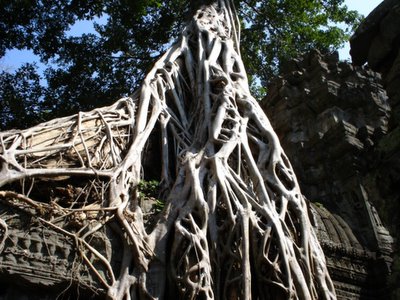
When I had first looked up the Banana on the web, I knew immediately that I wanted to stay there just because it was so cute. (also right price, right location). I am used to reading websites produced in countries where English is not their first language, and always get a giggle out of the cute mistakes. When describing the hotel, I had thought they had meant to say “A happy and friendly place”, but because of that language thing, had inadvertently written, “A gay friendly place”. I laughed and wondered if anyone had pointed out their error in language usage. But then I kept reading and noticed that there were absolutely no errors in the rest of the text. (hey, don’t blame me, I do this for a living) I looked again at the first line, and then down to the “Guest Comments” and, whoops, I was the one who had made the language error.
Having stayed there, I can attest to the fact that it is a happy and friendly place that also happens to be gay friendly. And if this is the norm for such travelers, in my future journeys I will definitely be logging onto gay travel sites to search for accommodation.
More to follow,
Kate

 I’m screwed!, I said to myself as I stepped off the plane in Siem Reap, Cambodia. It was overcast and cold, at least compared to the 98 degrees it was the day before in Ho Chi Minh City. And it was certainly not the 88 degrees CNN weather had predicted. It was in the low-seventy’s, which was not hot enough for the dresses I had planned to wear.
I’m screwed!, I said to myself as I stepped off the plane in Siem Reap, Cambodia. It was overcast and cold, at least compared to the 98 degrees it was the day before in Ho Chi Minh City. And it was certainly not the 88 degrees CNN weather had predicted. It was in the low-seventy’s, which was not hot enough for the dresses I had planned to wear.
I cruised swiftly through customs, walked out of the tiny airport, which was about the size and noise level of a rural bus stop, and started to search for my ride among the six people holding up signs. I didn’t see either my name or my hotel, The Golden Banana. I talked to a few of the taxi drivers and after twenty minutes, hired one of them to take me into town.
Driving along the road, I started to notice rain drops appearing on the windshield. I tried not to freak and asked the driver, is it raining? “No,” he said, “this isn’t rain.” OK, so it really was just a few sprinkles that soon stopped.
We continued along a two-lane road, past pretty, rural landscapes with oxen and chickens and small houses. A few minutes after that we began to pass enormous, five-star resort hotels that seemed very out of place in this bucolic setting. Along the river we rode, crossing over a bridge, then onto an unpaved road, and left into a narrow, dirt alley.
The B&B was even cuter than the pictures on their website. One enters into a nice sized, tiled patio with a few round, wooden tables and chairs, all engulfed in tropical foliage; bougainvillea, banana tress, orchids, and more. Individual bungalows branch off to the right and towards the back. The reception desk/food order station sits at the far end of the courtyard. I walked over, introduced myself to the young men standing there, told the tale of no airport pick-up, and assured them I did have a reservation.
Pulling out a large ledger, they checked my name and said that I wasn’t due until the next day. Before I had a chance to panic, (I had been told by email that I had booked the last room available), they said that room 14 just happened to also be available that day. They invited me to sit down while they got the paperwork together.
The guy who seemed to be in charge, sat down next to me with the registration forms. The other one brought me an iced tea. A few other young lads appeared. All wore traditional clothing of loose, brightly colored cotton pants and light blue cotton shirts. They were all very cute and very charming. I pulled out my passport and handed it over. “Is this you?” asked the young man. Yes, I said. “But you were so young and beautiful”, he continued, staring at the passport photo and then back to me. Well, that picture is nine years old, I replied. You don’t think it looks like me? He gave it one more look and said, “No.”
Number 14, which I had been forewarned by the owner as being the least desirable of his 17 rooms, wasn’t bad at all except for the thick layer of Raid fog that enveloped the place, and the circulating sub-zero air. I started to choke, located the A/C switch, turned it off, and cranked up the ceiling fan. I quickly noticed that the only windows were tiny slits at the top of the back wall, so thought I would just leave the door open to air it out until I noticed the swarm of skeeters pouring in, and a sign on the wall asking to keep everything shut because of the little varmints. (Malaria/dengue fever/sleepless nights, being three reasons to comply).
In the coming days, I would notice one of the guys entering all the rooms to give them a good dousing of Raid at least once a day. I was eventually able to get them to not spray in my room, or so I thought, even though the room stunk like insecticide the entire time I was there. Back in HCMC, I have had to throw every article of clothing that I took into the washing machine and dump my bag on the balcony as it still reeks of toxins!
I wasn’t planning on hitting Angkor until the next day, so after I left my room, (rather rapidly, I must say), I got a map and walked the short distance to the center of town. I savored walking down dirt roads and paved streets that were incredibly quiet and slow compared to what I had just left. One barely needs to stop before crossing the street. I looked forward to the “quaint French colonial architecture” noted in the guide books. Unfortunately, that entire, five-square block area is currently being refitted with new sewers.
Both sides of most of the central streets had gaping holes where backhoes had dug deep into the earth. The dirt that had been dumped onto the streets turned to mud as a result of the sewer water that now leaked out. I slogged through inches deep sewer mud trying to ignore it and get a sense of the town. I think it really must be cute in an un-dug-up state.
Restaurants, catering to tourists, line the streets, most with wide verandas filled with comfortable chairs and tables. I eventually stumbled on The Red Piano and decided I might as well get something to eat even though the sewer renovation project was in full swing less than half a block away.
Looking at the menu, which had almost every kind of food available save the local fare, I wondered if I had made a mistake. Then I spotted a Cambodian fish soup and ordered it. It arrived with a plate of dried cold rice. I dipped my spoon in, took a sip, and, damn, I had forgotten too ask for no MSG. I went about removing the chunks of fish and put them on the dried out rice. I took a bite. It tasted like soggy styrofoam. I managed to get down two pieces before I had to stop.
With a full bowl of soup sitting in front of me, I asked for the check. It was only $3, so no great loss, but I would never recommend that place, even if it is where Ms.Tomb Raider hung.
I never go to a place for food, but I do go to find local handicrafts, so I walked a block to the Old Market hoping to get a heads up on the arts and crafts available. There didn’t seem to be much. Most of it I had already seen in Vietnam and the prices were crazy-expensive. This was not proving to be a very interesting outing, so I trucked on back to the hotel.
I sat at a table and some of the staff joined me. I enquired about the best way to do the Temples and decided on hiring a tuk-tuk, (pronounced like ‘2’, with a ‘k’ at the end), and a guide for the next day. I had already decided on purchasing a three-day pass. That settled, I ordered a bottle of water and sat there enjoying the calming, peaceful surroundings.
Staff members came and went, joining me at the table to talk. I got a short Khmer lesson from one of them. It turns out the alphabet has something like 33 consonants and 22 vowels. There numbers go 1, 2, 3, 4, 5, 5+1, 5+2, etc. Only later did another guest point out that it was exactly like roman numerals and that really helped to organize it in my brain, not that I really remember any of the numbers I had so diligently repeated and transliterated into my notebook.
After the language teacher left, I noticed another staff member transforming lotus flower buds into decorative objects. I beckoned him over. He showed me how you gently peel back a petal, fold it in half, then bend it at an angle to the right, repeat to the left, again to the right, then tuck it into the base of the bud. You continue doing that to all the petals until you end up with a rose-like creation. I worked on a few of them. Some of my petals kept unfurling, but with enough practice I think I could master it.
By early evening I had also talked to several of the other guests who came to relax in the courtyard, most ordering something to drink or eat. It is the friendliest place I have ever stayed. People who had been there a few days were happy to give recommendations about where to go and what to see; how to avoid the hoards of tour buses; the best times to see which temples; where to buy souvenirs. I felt as though I were among old friends.
I think I finally went to my room around 9pm. I would have to be ready and waiting for my guide and driver at 7am. The room still smelled pretty bad, but I wasn’t too concerned. It had been a good day.
Kate
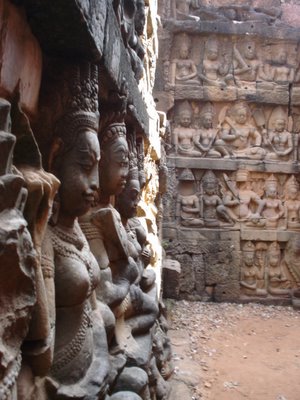
 I fly to Siem Reap, and the temples of Angkor, in about 15 hours. I have spent the day sorting out clothing for the week and packing. As long as I have been traveling around, I still cannot ever manage to take the right things, even though I spend hours planning and packing. Or rather, I take a bunch of stuff and then wear the same two items.
I fly to Siem Reap, and the temples of Angkor, in about 15 hours. I have spent the day sorting out clothing for the week and packing. As long as I have been traveling around, I still cannot ever manage to take the right things, even though I spend hours planning and packing. Or rather, I take a bunch of stuff and then wear the same two items.
The morning was filled with trying on outfits, deciding which would be the most comfortable as well as fashionable. I ironed everything, then laid it out according to the day it would be worn. I was quite impressed with my systematic approach to travel preparedness, and even more thrilled that I had accomplished it all before noon.
I needed some last minute things from the supermarket, so wandered out at 1:00. It started to dawn on me, as I walked home in the 98 degree heat, that the pants and t-shirt items I had so carefully chosen would kill me if I hiked around jungle and ruins all day. Back in the house, I quickly went about replacing almost all the clothes I had previously decided upon with skirts and jungle dresses. (not to be confused with Saturday Night/Office dresses.)
Even though I had checked the weather in Siem Reap, I started to get worried that maybe I would end up freezing, as I had done in Bali a few years ago. So, back in went a few pairs of pants. I think I now have a proper assortment of garments to accommodate any possible climate.
I also have every possible personal care item that one may need for a five day trip. This time I am bringing my own pillow and sheet. The sheet is because it seems that people in every country outside of the US do not use top sheets. And the places I stay in do not wash the top sheet cum blanket between guests. Yuck! If that isn’t enough to stave off sleep, there is always the 15 year old, rock hard pillow.
Yesterday I ran into town to buy a small backpack, film, and a few other things. I got a pack that I had assumed was a North Face forgery because it only cost $10. But when I got it home I looked at it more carefully. I think it is the real deal. I am not quite sure how that is possible. It is an uninteresting grey, but that was my color choice and I was in a hurry to get out of the center of the city.
Tet is less than a week away and everything is pretty crazy. Lots of shopping going on and lots of people everywhere. One of the major streets is blocked off and they are turning it into some sort of pedestrian garden, complete with little ponds. I only saw the beginnings but hope to see it next weekend. There is also something going on just around the corner from my house. I am not sure what it is, but it looks like vender stands have been erected on both sides of a side street next to my building, extending at least a kilometer. I thought it wouldn’t be ready until next week, but I just looked out my window, and they have turned the street out back into a motorbike parking lot. I suppose I should go out and see what is going on. Guess not. I looked outside again, and now about 100 motorbikes are lined up and revving their engines, waiting to pay the parking fee and get back on the road.
Just think, this time tomorrow I will be communing with the spirits of Angkor!
Kate
 I have another week to teach, and then I’ll get two weeks off for Tet. (Lunar New Year). The University takes such a long break because no one would come to class if they did anything less. Everyone travels to their town of origin, (or their parent’s, or grandparent’s hometown). It’s not a paid break, but that’s life in the world of teaching English.
I have another week to teach, and then I’ll get two weeks off for Tet. (Lunar New Year). The University takes such a long break because no one would come to class if they did anything less. Everyone travels to their town of origin, (or their parent’s, or grandparent’s hometown). It’s not a paid break, but that’s life in the world of teaching English.
Since I don’t intend to re-visit the land of any of my ancestors, I am going to Cambodia for about five days. Specifically, Siem Reap, gateway to Angkor. After beaches, old ruins are my favorite destination for travel. I’ve been busy reading up on the place, which one needs to do. I had no idea that the temples spread out over 40 miles. And I had thought the whole thing was called Angkor Wat, when, in reality, that is the name of just one temple.
I have also made reservations for a nice, budget hotel, on recommendation from some folks at work. I had been told to try and get something at the Red Piano Hotel and Restaurant. When I went on-line, I found that this popular abode has become even more so, ever since the cast and crew of Laura Croft, Tomb Raider, hung out at the restaurant between shots. (Although I have no doubt that they stayed at a 5 star hotel to sleep).
I was going to buy my ticket at Siem Reap Airlines. I walked the few blocks from the bus stop to their offices, to find an empty shop, the innards being torn out. Back across the street to a travel agent to ask where Siem had moved to. Address in hand, I set out.
A few blocks up the street I saw a man sitting on a small, plastic stool, with a makeshift table in front of him. I could see he was making something out of green bamboo leaves. I walked closer and saw the most incredible grasshoppers made entirely of cut and bent leaves that had been woven together. They were about eight inches long, and suspended from a long stick of cut bamboo leaf. Or maybe it was some other type of leaf.
I really wanted to talk to the man and find out where he learned how to make them. I think I remember hearing that grasshoppers brought good luck. But all I could do was ooh and aah, and buy two of them. He smiled at his grasshoppers and, before giving them to me, he kissed the tips of two fingers then waved them towards the critters. I was so excited about my purchases that I barely noticed the heat and noise of the city.
Arriving at the Siem Reap new offices, I found out that they no longer fly directly to Cambodia, and I had to return to the place where I had gotten the directions. Although in between I ran a couple of errands and almost got on the bus home before realizing I had yet to buy the plane ticket.
Back home, I got on the bike to ride to the supermarket. Once again, the tires were flat. This seems to happen every time I take it out for a spin. It’s not a problem, as I just pushed it a few blocks until I found a repairman. Usually you find them near a main intersection, sitting on a stool with a beat up bag of worn tools and findings.
This time, it was a pair of men, listening to a taped-together radio with really bad reception. They pumped up my tires, and the back one went flat immediately. Several other people, (they all appeared to know each other), came by and offered help and suggestions. When nothing worked, I understood that one would go and buy an inner tube. I sat on a stool, the younger guy took off on his motor bike, and more people joined our group.
Returning with the inner tube they, non-too-gently, threw my bike on the ground, then upside down to get the rear tire off. Then again, this a Vietnamese bike and built like a tank. It would take a lot more than that to damage it. By the time all was said and done, six people were observing and commenting on the progress of it all. I asked if they were there everyday, as I am sure the front tire also needs a new inner tube. I think they understood and I think that that is their corner. I’m sure I will find out soon enough.
The other exciting news is that I can finally see in my kitchen, which runs along a wall with no windows. When I moved in, this apartment was full of either florescent lights or 60 watt bulbs, and I have been slowly replacing them. The problem has been that it is very difficult to find 100 watt bulbs where I live and then once I do, I am not tall enough to change them.
Climbing on chairs and counters this afternoon, I managed to get the mini, 60 watt bulb out of the hanging light fixture. But when I tried to put in the new one, the whole socket came off and I could see it was corroded.
What was I going to do? It was Sunday. Then I remembered where I live and that anything can be done at any time. I sent a text message to my realtor friends and they had the electricians over in ten minutes. It did take another hour before they got back with supplies, but they fixed it in no time.
And I do believe that the dry season has finally arrived. The last rain was New Years Eve, and not a drop since then.
Kate

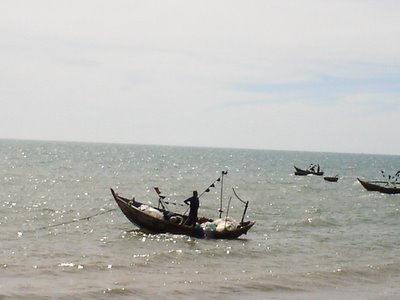 I think I can write, and I know I can teach, but I am feeling extremely challenged teaching students to write academic papers. This term, I was “awarded” the highest level class, the one students take before being admitted into the degree programs. It is only a four week course, and if they fail, they do not pass GO and do not collect $200.
I think I can write, and I know I can teach, but I am feeling extremely challenged teaching students to write academic papers. This term, I was “awarded” the highest level class, the one students take before being admitted into the degree programs. It is only a four week course, and if they fail, they do not pass GO and do not collect $200.
This week I am supposed to teach them how to write a “critical review”. If someone told me to sit down and write such a paper in response to a given article, I am sure I could do it. Teaching it is another thing, especially since neither the student’s book nor the teacher’s book actually tells you what is required. I have been doing cartwheels and back-flips trying to get lessons together that might actually teach the students what they need to know.
Tomorrow I am supposed to introduce Oral Presentations, which they will be required to do in four weeks. Is there any real information about exactly what is required? Not to my understanding of the book. And how are they supposed to choose a subject? From my umpteenth reading of the text, I assume it has to be on something related to English as a Global Language, but it all seems very vague. (By the way, please note the two examples of rhetorical questions in this paragraph. At least I was able to explain that one today.)
Most maddening about it all is that I am required to teach a bunch of extra hours which I did not want, especially after last terms crazy schedule. However, it will only be for four weeks, and there is a two week break in the middle, so it is not the end of the world. (Although yesterday morning’s class had me really wondering about it.)
I guess it all really boils down to the fact that I don’t like anything even vaguely academic. I am trying my darnedest to make the class entertaining, as it is my solemn belief that if people are laughing, they are learning. But god, how can you make note-taking on a lecture about making processed bread in Australia fun?
It isn’t all bad. I do enjoy the students and I still like teaching. I just don’t like feeling that I am not giving them enough of what they will need to pass the course. Who knows, maybe we will all land on Marvin Gardens and life will be bliss.
Kate
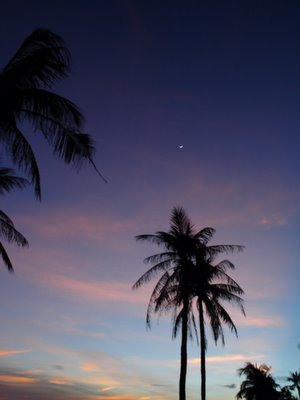
 My favorite place in the whole world is a beach. Preferably a tropical beach, on a hot sunny day. And that’s where I went for a few days. I set out for Mui Ne, 200K south of Ho Chi Minh City, on Tuesday morning, and got back Thursday night.
My favorite place in the whole world is a beach. Preferably a tropical beach, on a hot sunny day. And that’s where I went for a few days. I set out for Mui Ne, 200K south of Ho Chi Minh City, on Tuesday morning, and got back Thursday night.
As usual, with Delta Adventures, and I think with any tour bus company in Vietnam, the 7:15am bus left at 8:15, and the four hour trip was close to six hours. But it was worth it.
Mui Ne may not be the closest beach, but it is the one everyone recommends. I tried to find out about accommodations from people at work, who did give me a few tips on budget places, but most said to “Just get off the bus and look for a place”. Fortunately, I did not listen to their advice. There is nothing worse than hauling your crap around in the noon-day sun as you go in and out of hotels trying to find a reasonable place at a reasonable price that has vacancies. When I booked the ticket, I was handed a brochure for a “resort” that cost $15 a night, was on the beach, had a pool, and looked decent. I ended up calling the owner and booking a room.
The beach front hotels run along a twenty kilometer strip, the center of which is Kilometer 12. I was told that I should look for lodging in that area so that I could wander out at night to the various restaurants. I wasn’t sure how far my hotel was from the center, but figured it couldn’t be that far away. I thought about this as the bus rolled on and on before it dropped me at the Minh Tam resort, at kilometer 15.
The young woman at reception came out to greet me. I must say that I was not in the best of moods; it had been close to seven hours since I’d left my house, I was dehydrated and probably in need of food. Still, the place looked lovely. Small structures, with rooms on two floors, surrounded a courtyard and pool. To the left was a thatch-covered, open-aired, restaurant. All was quite simple, but clean and inviting. Best of all, was the sound of the surf and ocean breeze.
I got into my room, changed into beach attire, and headed for the pool. There were six beach lounges, all taken. But then I noticed a walkway on the far side of the pool that ran along the short sea-wall. It was filled with lots of comfy chairs and little thatched-roof tables. I threw my towel down, got out the Harry Potter, and baked in the sun. Sitting there, despite the tranquility, fantastic weather, and good book, I couldn’t help thinking I had made a mistake and that I should have taken a hotel 3 kilometers down the road. I just wasn’t feeling relaxed or happy.
After my hour in the sun and a shower, I decided to take a walk to see what was available down at kilometer 12. I walked along the narrow two-lane road, past abandoned buildings, buildings in progress, fishermen’s houses and shacks, an occasional hotel, and crews putting in an expansive, multi-colored, tiled sidewlk. Palm trees sprung up out of it every ten feet. Some parts were completed, others not even started. Often, I had to walk in the street and watch out for the speeding buses, although traffic was not that bad. I passed Kilometer marker 14, then 13, and was starting to think that this was not at all fun and maybe I should just take the bus back the next day.
As I walked on, and as the hotels began to become linked at the seams, I noticed that you could walk into any of them and go straight through to their beach restaurant and then the beach. I entered a surf shop and ended up at a kite-surfing operation.
 I had heard this was all the rage in Mui Ne, and could now understand why. There weren’t any real waves to speak of, but a good amount of wind. I had never before seen this sport except on TV. Basically, you strap on a harness, slip your feet into straps on a short board, and hang on to a crescent moon-shaped kite. (don’t know the dimensions, but it is huge). And then you let the wind carry you away. I had no desire to try it, but it seemed hundreds of people, at several different shops, were very eager to do so. I continued my walk, this time on the beach, still feeling like maybe this was a mistake.
I had heard this was all the rage in Mui Ne, and could now understand why. There weren’t any real waves to speak of, but a good amount of wind. I had never before seen this sport except on TV. Basically, you strap on a harness, slip your feet into straps on a short board, and hang on to a crescent moon-shaped kite. (don’t know the dimensions, but it is huge). And then you let the wind carry you away. I had no desire to try it, but it seemed hundreds of people, at several different shops, were very eager to do so. I continued my walk, this time on the beach, still feeling like maybe this was a mistake.
But then I looked down and saw seashells. Seashells! Oh, I had forgotten about one of the best reasons for walking on a beach! I immediately started picking them up and tossing them in my bag, deciding if this one would be good for earrings, of if that one would do better on a collage. And just about then, the beach took hold. Hey, I thought, this is where I derive life force, this is the place that brings me inner peace, this is why I came here. And just like that, I was cured of any desire to leave.
I also realized that this section of Mui Ne sucked, and I was ever so grateful that I hadn’t gotten off the bus here. It was packed with mostly western tourists, being loud and guzzling beer. At the time it really bothered me, but later I thought, well, what did you expect? People come to the beach to drink, surf, and party. I come to mellow out, which is what I could do back at my little resort.
As I walked the 3K back, the sun began to set behind me. The sky filled with bright pinks and a sliver of moon glowed over it all. I made it back before it was completely dark, and went into the restaurant area to see what was available to eat. I’d seen them grilling some calamari earlier, and it had smelled awfully good.
A was a bit taken aback by the prices on the menu. The place may be called a “resort”, but it was just a simple place, yet prices were as high as some of the really fancy places down the road. All things being relative, it really wasn’t that expensive. I got the grilled calamari and a cold bowl of rice. I soon learned that the restaurant part of the hotel needed some serious work. One can’t blame the help, though. They simply didn’t know how a restaurant works and obviously the owner wasn’t interested in showing them.
After eating, I again went out to the sea-wall chairs. A few other guests were out, either quietly talking or just watching and listening to the sea as it rolled in a few feet below us. I glanced up to look at the moon and was greeted by the sight of millions of stars. I gazed up in amazement. I can’t even remember the last time I have seen that many stars. No longer was the sky spotted with an occasional cluster of blinking lights, but was blanketed with twinkles. There aren’t any blank spaces. I knew this, but had forgotten. How was I ever going to live with the meager sight I have to look up at every night in the city?
I got up early the next morning determined to get a pool chair. I’d noticed that the couple who had snagged the best seats when I’d arrived had not vacated them until after the sun went down. First, though, I sat down to drink some tea.
From where I sat, I had a good view of the small fishing boats anchored within swimming distance of the shore. Then I saw a group of ten people, in single file, hauling in a net. I got up and walked down to the beach. Slowly and methodically, the eight women and two men hung on to a rope and walked backwards. They had a rope belt around their waists with a cord attached that, in turn, wrapped around the line they pulled. As one of them reached the wall, he would unfasten his cord, walk into the water at the front of the line, reattach himself, and continue to pull. There was a definite, hypnotic type rhythm to the process.
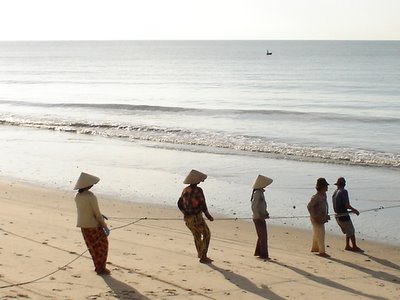
I glanced out onto the sea and saw that two men in two boats were directing those on the beach. Occasionally, the people pulling moved to their left a few paces, without breaking stride. It was around that time that I noticed a second group of ten, hauling in the other side of the net. It must have been close to an hour before the net started to emerge from the water.
Now, when a person went to the front of the line, she scooped the net, twisted it over the line, and reattached her belt cord around it. Other people started to appear on the beach with baskets and buckets. When the entire net was on the shore, the process of opening it and extracting fish began. I walked down to take a closer look, along with several other tourists.
One Canadian-Vietnamese man was asking questions and translating for me and another man. Out of all that work, there seemed to be about three large baskets of small fish. Some would be to eat, some to sell. He talked to the women in charge who told us that the share for each of the workers would be 2000 VND, about 20 cents. A young boy was rewarded two, good-sized fish for helping with the hauling in.
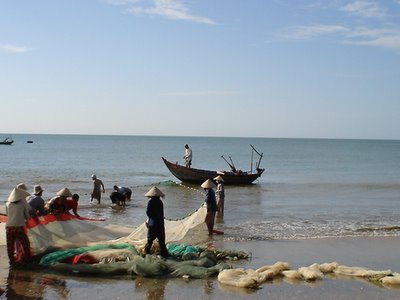 I started to talk to another, middle-aged couple, also Canadian-Vietnamese. I asked when they had last been back. It was their first trip in thirty-five years. I made some comment that it must be wonderful, to which they replied that they had very mixed feelings. They seemed to be most bothered by the poverty. They had been in Vietnam a few weeks, and would soon be joined by their sons, one of whom was about to get his PhD from MIT.
I started to talk to another, middle-aged couple, also Canadian-Vietnamese. I asked when they had last been back. It was their first trip in thirty-five years. I made some comment that it must be wonderful, to which they replied that they had very mixed feelings. They seemed to be most bothered by the poverty. They had been in Vietnam a few weeks, and would soon be joined by their sons, one of whom was about to get his PhD from MIT.
The head women came over to us and again I heard a bit more about their lives. I was curious to know if they lived behind us, next to my hotel. She said some did, while others lived farther away. My translator said he was very surprised to see people still engaged in this type of work, and figured it would be a matter of only a few years before tourism replaced fishing.
 Eventually, all the fishermen went home, and I went back up to the pool, to find that yesterdays couple was eating breakfast, but had all their stuff covering the only two pool chairs that had sun. I knew they would be in for the long haul.
Eventually, all the fishermen went home, and I went back up to the pool, to find that yesterdays couple was eating breakfast, but had all their stuff covering the only two pool chairs that had sun. I knew they would be in for the long haul.
I picked out one of the remaining two lounge chairs, and tried to move it to a better position. There was not a whole lot of room in which to do this, and the chair was made of something equivalent to solid oak. So as I pulled it, the back rest collapsed on to my forearms. Fortunately, they had ice that day, so the swelling was kept to a minimum, and it is still not bruised, but for about an hour there I thought I had cracked a bone.
This time, I cooked for a little less than two hours, went back in to hose off and get ready for the shoreline walk. Now that I was thoroughly into the beach lifestyle, I could start to dress properly. I threw on a sarong and tank top and took off down the beach, plastic shell-collecting bag in hand.
As I walked, I passed a group of giant, woven, tub-like baskets that the fishermen use as row boats to get out to their fishing boats. From what I saw, only one or two people ride in them, but they look like they could easily hold five people. They row with a paddle that is attached to the front of the basket, while standing up, and using a motion that looks like they are stirring a cauldron in front of them. They push the oar out and bring it round in a half circle until it meets the boat, then do the same in reverse. I have no idea how in the world that could make you move forward in a straight line.
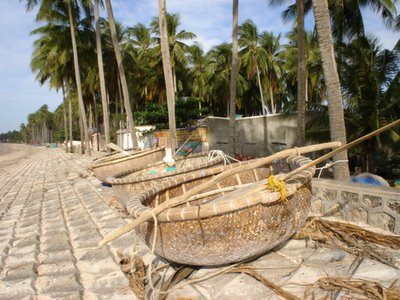 On the way back, I stopped at a little shack to get a drink. Out in front were various family members including the cutest one-year-old boy. I had said hello, and had started to go towards the drinks when I felt little arms latch onto my leg. I looked down to see the cute kid hanging on, and everyone laughing. I reached down and he took hold of my finger and was not about to let go, as he stared straight into me. I then realized that I was wearing a shocking pink, patterned sarong, and the kid was going nuts for the color. When I tried to walk away, he began to cry. I had to hang with him a few minutes before I left.
On the way back, I stopped at a little shack to get a drink. Out in front were various family members including the cutest one-year-old boy. I had said hello, and had started to go towards the drinks when I felt little arms latch onto my leg. I looked down to see the cute kid hanging on, and everyone laughing. I reached down and he took hold of my finger and was not about to let go, as he stared straight into me. I then realized that I was wearing a shocking pink, patterned sarong, and the kid was going nuts for the color. When I tried to walk away, he began to cry. I had to hang with him a few minutes before I left.
It was close to five when I got back. I thought I could jump in the shower before I took sunset pictures. But the electricity was still off as it had been since noon. (no electricity = no water pump to the upstairs rooms). It didn’t matter, the sun goes down early here and sitting outside to watch all of it was better then going inside for any reason.
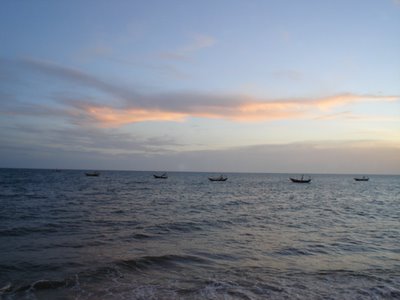 I watched and listened to the day end on the beach in Mui Ne. I spent more time fixated with the heavens. I realized, once again, that I wanted to live at the beach. There really is no better place that I know of.
I watched and listened to the day end on the beach in Mui Ne. I spent more time fixated with the heavens. I realized, once again, that I wanted to live at the beach. There really is no better place that I know of.
Sporting quite a tan,
Kate






























